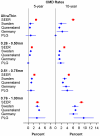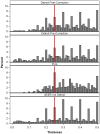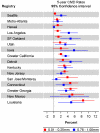Miscoding of Melanoma Thickness in SEER: Research and Clinical Implications
- PMID: 27354265
- PMCID: PMC5077675
- DOI: 10.1016/j.jid.2016.05.121
Miscoding of Melanoma Thickness in SEER: Research and Clinical Implications
Abstract
Melanoma-related deaths and metastases among patients with thin (≤1 mm) and ultrathin (≤0.25 mm) melanomas have been reported. These observations might reflect adverse biology and/or errors in administrative data. Cumulative melanoma-related death rates for thickness groups of patients with thin melanomas were compared among five cohorts including the Surveillance, Epidemiology, and End Results (SEER) registry. Thickness in one SEER region was reexamined in pathology reports. The 5-year cumulative melanoma-related death rate of patients with ultrathin melanomas was higher in SEER (2.8%) compared with other registries (0.6-0.9%). The rates across the 16 SEER regions were 0.25% to 8.4%. In SEER, 21% of thin melanomas were ultrathin; in other registries, they comprised 5.8-15%. A reexamination of thickness in one SEER site revealed that 114 of 447 ultrathin melanomas had errors; after correction, only 17 of the 114 remained ultrathin. The majority of errors were related to decimal point placement. The 86 thin melanomas reclassified to >1.00 mm included 96% of the original ultrathin-associated deaths and 100% of the original positive lymph nodes. Significant miscoding of thickness that is concentrated in ultrathin lesions is present in SEER and results in mischaracterization of patient outcomes. When using administrative data, validation of results can identify critical data issues.
Copyright © 2016 The Authors. Published by Elsevier Inc. All rights reserved.
Figures



Comment in
-
Administrative and Survey Data: Potential and Pitfalls.J Invest Dermatol. 2016 Nov;136(11):2122-2124. doi: 10.1016/j.jid.2016.07.022. J Invest Dermatol. 2016. PMID: 27772544
-
Utility and Limitations of Large Population-Based Data for Skin Cancer Outcomes.J Invest Dermatol. 2016 Nov;136(11):2128-2130. doi: 10.1016/j.jid.2016.07.031. J Invest Dermatol. 2016. PMID: 27772547
References
-
- Bagaria SP, Ray PS, Joseph RW, Heckman MG, Rawal B, Gray RJ, et al. Ultrathin primary is a marker for worse prognosis in lymph node-positive cutaneous melanoma. Cancer. 2013;119(10):1860–7. - PubMed
-
- Balch CM, Soong SJ, Gershenwald JE, Thompson JF, Reintgen DS, Cascinelli N, et al. Prognostic factors analysis of 17,600 melanoma patients: validation of the American Joint Committee on Cancer melanoma staging system. J Clin Oncol. 2001;19(16):3622–34. - PubMed
-
- Clark WH, Elder DE, Guerry D, Braitman LE, Trock BJ, Schultz D, et al. Model predicting survival in stage I melanoma based on tumor progression. J Natl Cancer Inst. 1989;81(24):1983–1904. - PubMed
-
- Collins GS, Reitsma JB, Altman DG, Moons KG. Transparent reporting of a multivariable prediction model for Individual Prognosis or Diagnosis (TRIPOD) Ann Intern Med. 2015;162(10):735–6. - PubMed
-
- Criscione VD, Weinstock MA. Melanoma thickness trends in the United States, 1988–2006. J Invest Dermatol. 2010;130(3):793–7. - PubMed
Publication types
MeSH terms
Grants and funding
LinkOut - more resources
Full Text Sources
Other Literature Sources
Medical

